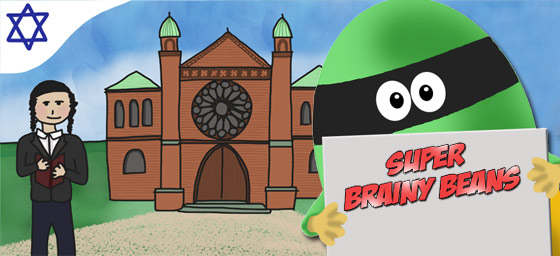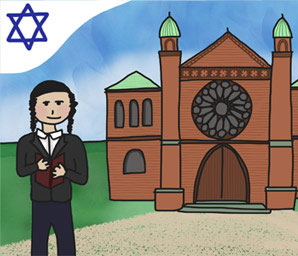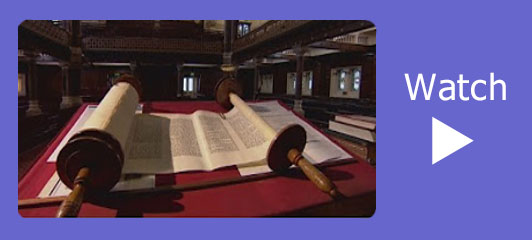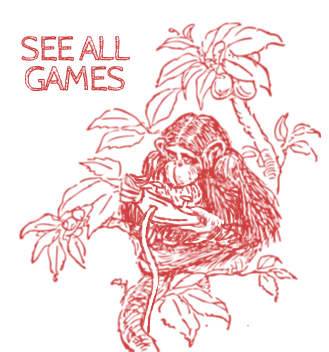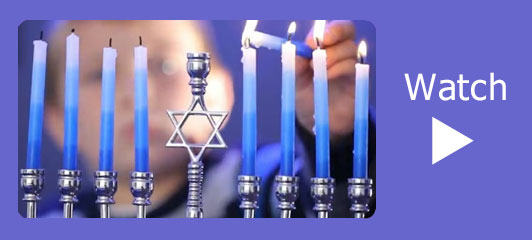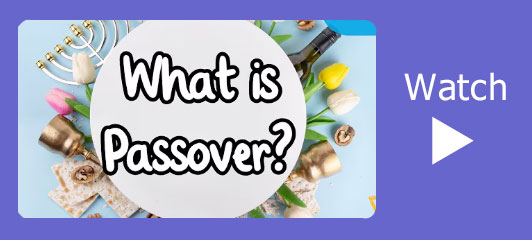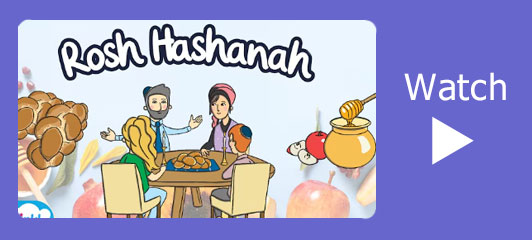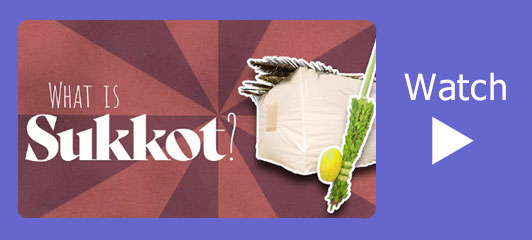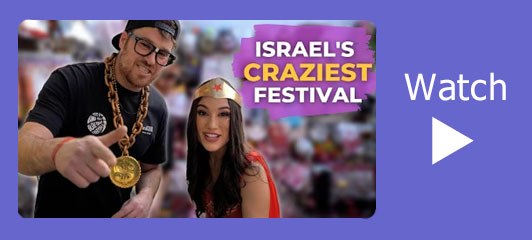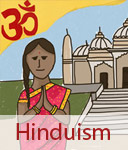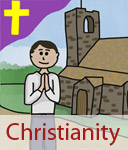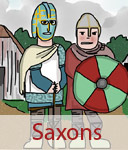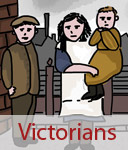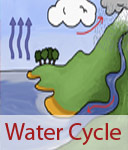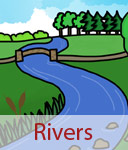Judaism for kids
Judaism for kids in Primary Learning. Homework help with what is Judaism, how Jew's worship and what there holy festivals and traditions are.
What is Judaism?
Judaism is one of the oldest religions in the world, beginning over 4,000 years ago in the Middle East. Jewish people, also called Jews, believe in one God who created the world. They believe God made a special promise, called a covenant, with Abraham, one of the first leaders of the Jewish people. In this promise, God said He would look after Abraham’s family (the Jewish people) and give them the land of Israel, if they followed His laws and lived holy lives.
Judaism teaches people right from wrong, the importance of living a good life, and how to treat others with kindness and fairness.
 Judaism for kids
Judaism for kidsCelebrations, sacred spaces, basic beliefs and resources on Judaism.
 Britannica Kids - Judaism
Britannica Kids - JudaismMore information on Judaism and their way of life and beliefs.
What are the symbols of Judaism?
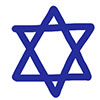
The Star of David
This six-pointed star is the best-known symbol of Judaism. It is named after King David, and is often seen on synagogues and the flag of Israel. Some say it represents the shape of King David’s shield.
The Menorah
A special lampstand with seven branches, one of the oldest symbols of Judaism. It reminds Jews of the lamp that stood in the Temple in Jerusalem.
The Mezuzah
A small case fixed to the doorpost of Jewish homes. Inside is a tiny scroll with the Shema prayer, which says “Hear, O Israel: The Lord is our God, the Lord is One.” Jews touch the mezuzah with their fingers when they pass through the door as a sign of respect.
Jewish beliefs
One of the most important beliefs in Judaism is that there is only one God. Jews believe God created the whole universe and cares deeply for the world and everyone in it. This makes Judaism one of the very first monotheistic religions – religions that believe in just one God.
Jews also believe in something called the Covenant. This is a very special promise that God made with Abraham and later renewed with Moses. In this promise, God said He would look after the Jewish people, and in return, they agreed to follow His laws and live holy lives. This covenant is still remembered and honoured by Jewish people today.
Jews also believe strongly in kindness and justice. There is a special phrase in Hebrew called tikkun olam, which means “repairing the world.” This belief encourages Jews to help others, take care of the environment, and make the world a better and fairer place for everyone.
Judaism also has special rules about food called kosher laws. These laws guide what Jewish people can and cannot eat. For example, Jews do not eat pork or shellfish, and they never eat meat and dairy together in the same meal. Some Jewish families even have two sets of plates and pans – one for dairy and one for meat – to keep kosher properly.
Finally, a well-known tradition is wearing a kippah, a small round cap. Many Jewish men and boys wear a kippah when they pray, and some choose to wear it all the time. Wearing the kippah is a way of showing respect for God and reminding themselves that God is above them, watching over the world.
How do Jews worship?
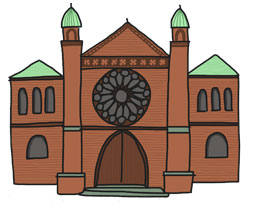 Jewish people worship in a synagogue, usually once a week on Shabbat (the Sabbath). A rabbi leads the community. A rabbi is a teacher who knows a lot about Jewish history, prayers, and the Torah.
Jewish people worship in a synagogue, usually once a week on Shabbat (the Sabbath). A rabbi leads the community. A rabbi is a teacher who knows a lot about Jewish history, prayers, and the Torah.
Inside the synagogue, you will often see:
- The Ark – a special cupboard where the Torah scrolls are kept.
- The Torah Scrolls – hand-written on parchment in Hebrew.
- The Eternal Light (Ner Tamid) – a lamp that always stays lit above the Ark, reminding Jews that God is always present.
Shabbat – The Day of Rest
The Sabbath (Shabbat) is very important in Judaism. It begins on Friday evening when the sun sets and lasts until Saturday evening. Jewish families light candles, share a special meal, sing songs, and rest from work. At the end, they hold a ceremony called Havdalah, with a braided candle, spices, and a cup of wine.
 Bitesize - Judaism
Bitesize - JudaismAll about Judaism. Learner guides and class clips.
Jewish Ceremonies
Brit Milah
A special ceremony for baby boys, when they are circumcised on the eighth day after birth as a sign of belonging to the Jewish people.
Bar Mitzvah / Bat Mitzvah
When Jewish boys turn 13 (Bar Mitzvah) and girls turn 12 (Bat Mitzvah), they are considered grown up in their religion and take on more responsibility.
Weddings
Weddings usually take place under a canopy called a chuppah, and the ceremony ends with the groom breaking a glass under his foot – a reminder of the destruction of the Temple in Jerusalem and that joy should be balanced with remembrance.
Funerals
Jewish funerals are simple and respectful. Families mourn together and remember the person’s life.
What is the Torah?
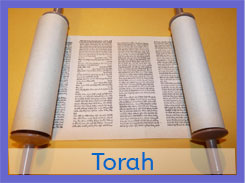 The Torah is the holiest and most important book in Judaism. It is part of the Hebrew Bible and contains the first five books, which are sometimes called the Five Books of Moses. Jewish people believe the Torah was given to Moses by God on Mount Sinai, making it a very sacred and special gift.
The Torah is the holiest and most important book in Judaism. It is part of the Hebrew Bible and contains the first five books, which are sometimes called the Five Books of Moses. Jewish people believe the Torah was given to Moses by God on Mount Sinai, making it a very sacred and special gift.
The Torah is written in Hebrew, the ancient language of the Jewish people. It is not printed like ordinary books but carefully handwritten by special scribes on long scrolls of parchment made from animal skin. Writing a Torah scroll takes a lot of time – often more than a year – because it must be copied with great care and no mistakes are allowed.
Inside the Torah are stories, history, and laws. It tells about the creation of the world, the lives of important people such as Abraham and Moses, and the story of how the Jewish people escaped from slavery in Egypt – known as the Exodus. The Torah also contains laws and teachings that guide Jewish people on how to live a good life, treat others kindly, and worship God.
In the synagogue, the Torah is kept in a special cupboard called the Ark. During services, portions of the Torah are read aloud, and over the course of the year the whole Torah is read from beginning to end. When Jews read from the Torah, they use a pointer called a yad (which means “hand”) so that the scroll is never touched directly. This helps protect the delicate writing.
Because the Torah is so holy, it is treated with deep respect. When a Torah scroll becomes too old or damaged to use, it is buried in a cemetery instead of being thrown away, as a sign of honour and reverence.
Festivals
Hanukkah - Festival of Lights
Hanukkah is one of the best-known Jewish festivals. It celebrates the time when the Jewish people won back the Temple in Jerusalem after it had been taken over by their enemies. When they made the Temple holy again, they wanted to light the menorah – a special lamp – but there was only enough oil to last one day. Miraculously, the oil kept burning for eight days, which gave them enough time to prepare more oil.
To remember this miracle, Jewish families light a special nine-branched menorah called a hanukkiah, adding one candle each night for eight nights. Families also eat foods cooked in oil, like latkes (potato pancakes) and sufganiyot (jam-filled doughnuts). Children often play a spinning top game called the dreidel, which has Hebrew letters on each side.
Passover/Pesach
Passover, or Pesach, is one of the most important Jewish festivals. It remembers the time when the Jewish people were slaves in Egypt and how God helped Moses lead them to freedom. On the night of their escape, they left so quickly that their bread did not have time to rise. That’s why Jews eat matzah (flat, unleavened bread) during Passover.
A special meal called the Seder is held at the start of Passover. During the Seder, families eat symbolic foods from a Seder plate, such as bitter herbs to remember the bitterness of slavery, salt water to represent tears, and a roasted bone to symbolise the sacrifice offered in the Temple. Children are encouraged to ask questions about the meaning of the festival so the story can be passed on to each new generation.
Rosh Hashanah and Yom Kippur
Rosh Hashanah is the Jewish New Year and is a time for reflection and fresh beginnings. Families celebrate by eating sweet foods like apples dipped in honey to wish for a “sweet” new year. In synagogues, a shofar (a ram’s horn) is blown as a call to people to think about their lives and make positive changes.
Ten days later comes Yom Kippur, the Day of Atonement, which is the holiest day of the Jewish year. On this day, Jews fast for 25 hours (which means they do not eat or drink), spend time in prayer, and say sorry for the wrong things they may have done in the past year. Yom Kippur is a time for forgiveness, making peace, and starting the year with a clean slate.
Sukkot
Sukkot is a harvest festival that also remembers the time when the Israelites wandered in the desert after escaping from Egypt. During this period, they lived in temporary shelters. To remember this, Jewish families today build huts called sukkahs in their gardens or backyards. These sukkahs are decorated with fruit, vegetables, and colourful decorations, and families often eat meals inside them.
Purim
Purim is a joyful and exciting festival that remembers the story of Queen Esther, who bravely saved the Jewish people from danger in ancient Persia. It is a time of fun, dressing up in costumes, and making lots of noise in the synagogue whenever the name of the villain, Haman, is read aloud from the story.
People also give gifts of food to friends and the poor, and eat triangle-shaped pastries called hamantaschen, which are said to represent Haman’s hat!
Famous Jews
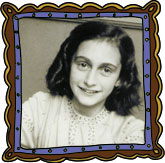
Anne Frank (1929-1945)
Anne Frank was a young Jewish girl who became famous after her diary was published. She and her family had to hide from the Nazis during World War II because they were Jewish. While in hiding, Anne wrote about her life, her hopes, and her dreams. Even though she was living in very frightening times, her diary shows she believed in kindness and hope. Her words have been read by millions of people around the world and continue to inspire children and adults today.
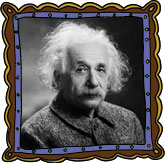
Albert Einstein (1879-1955)
Albert Einstein was a brilliant scientist and one of the most famous thinkers of all time. He developed the theory of relativity, which changed how people understood space, time, and energy. Einstein was Jewish and had to leave Germany when the Nazis came to power. He later moved to America and used his voice to speak out for peace, education, and fairness. Many people see him as not only a genius but also a role model for standing up for what is right.
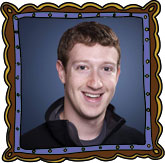
Mark Zuckerberg (1984-)
Mark Zuckerberg is a modern Jewish figure who co-founded Facebook, one of the world’s largest social media platforms. He grew up in a Jewish family in America and showed an interest in computers from a very young age. Today, he is one of the most successful technology leaders in the world. He has also donated large amounts of his money to education, health, and science to try to make life better for others.
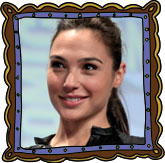
Gal Gadot (1985-)
Gal Gadot is an Israeli actress and model who is Jewish. She is best known for playing Wonder Woman in popular superhero films. Before becoming an actress, Gal served in the Israeli Defence Forces and worked as a model. She is admired not only for her acting but also for being a strong and positive role model, showing children everywhere that heroes can be brave, kind, and compassionate both on and off the screen.

